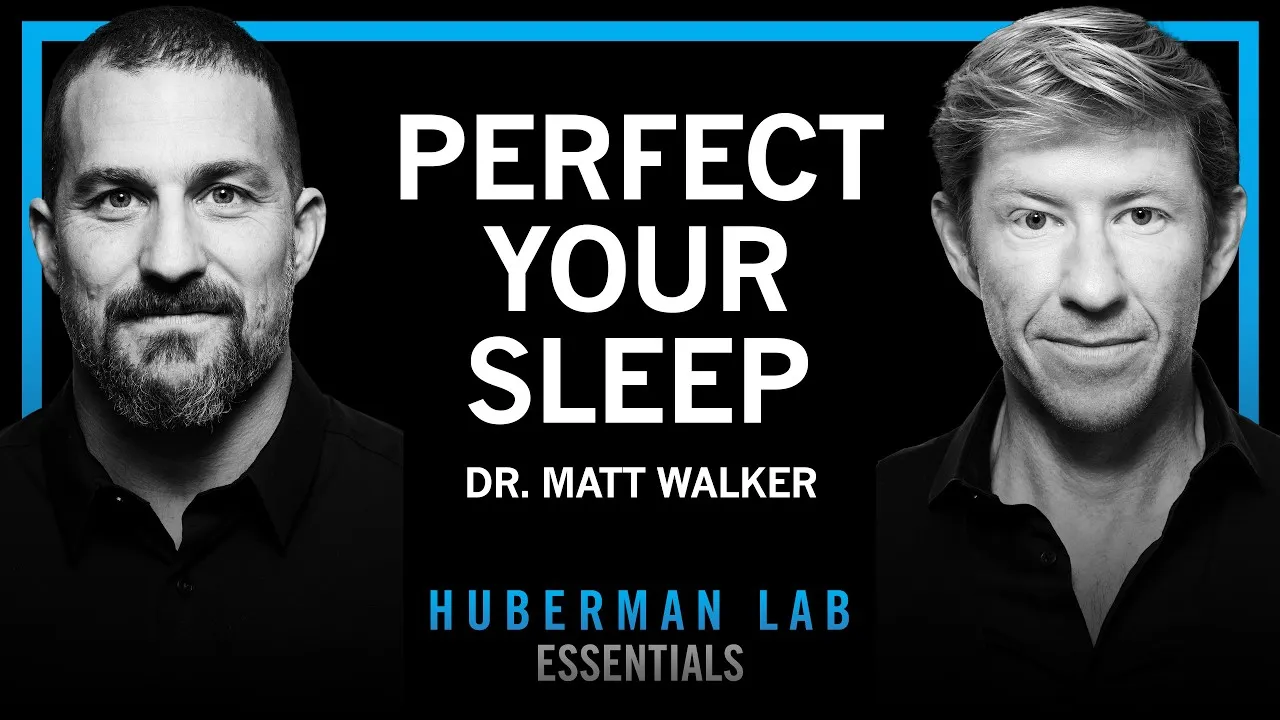Table of Contents
Discover proven sleep science from Dr. Matt Walker on REM cycles, caffeine timing, alcohol effects, and unconventional sleep tips for optimal rest and recovery.
Key Takeaways
- Sleep operates in 90-minute cycles alternating between non-REM and REM stages, with deep sleep dominating early night and REM sleep increasing toward morning
- Caffeine has a 5-6 hour half-life and 10-12 hour quarter-life, requiring cessation 8-10 hours before bedtime to avoid reducing deep sleep by 30%
- Alcohol fragments sleep quality through autonomic nervous system activation and blocks critical REM sleep, despite appearing to help you fall asleep faster
- Natural melatonin production is far lower than supplement doses, with optimal therapeutic amounts being 0.1-0.3mg rather than typical 5-20mg doses
- Strategic napping (20-90 minutes) provides cardiovascular, cognitive, and emotional benefits but should be avoided by those with nighttime sleep difficulties
- Behavioral interventions like consistent sleep timing, worry journaling, and proper light exposure are more effective than supplements for long-term sleep optimization
- Sleep fragmentation matters as much as total sleep duration—quality and quantity are equally essential for next-day cognitive and physical performance
Timeline Overview
- 00:00:00–00:02:05 — Sleep Structure and REM Paralysis: Understanding the fundamental architecture of sleep including non-REM and REM stages, why the brain paralyzes the body during dreams, and which muscle groups remain active during sleep cycles
- 00:02:05–00:07:08 — 90-Minute Sleep Cycles and Hormonal Timing: How sleep cycles progress throughout the night with deep non-REM dominating early hours and REM increasing later, plus specific hormonal functions tied to each sleep stage including growth hormone and testosterone
- 00:07:08–00:09:20 — Nighttime Awakening and Sleep Fragmentation: Why brief awakenings between cycles are normal with aging, when fragmented sleep becomes problematic, and how sleep quality matters as much as quantity for restoration
- 00:09:20–00:10:43 — Sunlight Exposure for Circadian Regulation: The critical importance of 30-40 minutes of natural daylight exposure for optimizing sleep timing, workplace studies showing dramatic sleep improvements from window access
- 00:10:43–00:13:42 — Caffeine Timing and Sleep Depth: Understanding caffeine's 5-6 hour half-life and quarter-life effects, why late-day caffeine reduces deep sleep by 30% even when you can fall asleep, and optimal cutoff timing strategies
- 00:13:42–00:16:23 — Alcohol's Sleep Disruption Mechanisms: How alcohol creates sedation rather than natural sleep, fragments sleep through autonomic activation, and potently blocks REM sleep critical for emotional regulation and memory
- 00:16:23–00:18:38 — Cannabis, THC, and REM Sleep Rebound: THC's effects on sleep onset and REM suppression, why people report intense dreams when stopping cannabis use, and the brain's attempts to recover lost REM sleep
- 00:18:38–00:24:44 — Melatonin Supplementation Reality Check: Why melatonin only increases sleep by 3.9 minutes on average, how typical supplement doses exceed natural production by 10-20 times, and when melatonin might actually be beneficial
- 00:24:44–00:27:02 — Prescription Sleep Aids vs Behavioral Therapy: Limitations of sleeping pills for long-term use, cognitive behavioral therapy's superior lasting effects, and why behavioral interventions should be first-line treatment
- 00:27:02–00:30:34 — Strategic Napping for Performance: NASA research on 26-minute naps improving performance by 34%, cardiovascular and cognitive benefits of 20-90 minute naps, and when to avoid napping for better nighttime sleep
- 00:30:34–00:34:45 — Unconventional Sleep Optimization Tips: The "do nothing" approach after bad sleep nights, creating effective wind-down routines, worry journaling techniques that reduce sleep onset by 50%, and removing clocks from bedrooms
Understanding Sleep's Complex Architecture
Sleep represents the most effective tool for resetting brain and body health, functioning as an intricate physiological process rather than simple unconsciousness. Dr. Matt Walker reveals how this nightly restoration operates through precisely orchestrated stages.
- Sleep divides into two main categories: non-rapid eye movement (non-REM) and rapid eye movement (REM) sleep, each serving distinct biological functions
- During REM sleep, the brain completely paralyzes voluntary muscles except for breathing, heartbeat, eye movements, and inner ear muscles to prevent acting out dreams
- The paralysis mechanism evolved as protective survival adaptation—without it, humans would physically enact dreams and face serious injury or death
- Eye movement preservation during REM occurs because prolonged stillness would create oxygen deficits in eye fluids and drainage problems similar to glaucoma
- Sleep cycles repeat every 90 minutes throughout the night, with each cycle containing both non-REM and REM components in varying proportions
This architectural complexity demonstrates why sleep cannot be easily shortened or modified without consequences. Every stage serves essential functions that Mother Nature preserved through millions of years of evolution.
The 90-Minute Sleep Cycle Journey
Each night, your brain orchestrates a predictable yet sophisticated cycling pattern that optimizes different types of restoration during specific time windows.
- Initial sleep begins with light non-REM stages one and two, where heart rate drops and brain waves slow from 20-50 cycles per second to 8-15 cycles per second
- After 20 minutes, descent into stages three and four deep non-REM sleep occurs, featuring remarkable coordination where hundreds of thousands of cortical cells fire and silence together
- First REM period emerges around 80-90 minutes into sleep, initially brief but lengthening with each subsequent cycle throughout the night
- Early night cycles contain predominantly deep non-REM sleep, which provides natural blood pressure regulation, insulin control, and metabolic restoration
- Later night cycles shift toward lighter non-REM and increasingly longer REM periods, supporting growth hormone release, testosterone production, and emotional processing
- Sleep deprivation of either early deep sleep or late REM sleep creates different dysfunction profiles—cardiovascular and metabolic problems versus emotional and cognitive impairments
This timing specificity explains why partial sleep loss cannot be easily compensated and why consistent full-night sleep proves essential for optimal health.
When Nighttime Awakenings Become Problematic
Brief awakenings between sleep cycles represent normal physiology, particularly with aging, but certain patterns signal concerning sleep fragmentation.
- Natural awakening occurs at the end of each 90-minute REM period, allowing postural adjustments after prolonged muscle paralysis
- Problematic awakening patterns include staying conscious for 20-25 minutes or experiencing 6-8 conscious awakenings throughout the night
- Sleep fragmentation destroys sleep quality even when total duration appears adequate, leading to unrefreshing rest and daytime impairment
- Quality and quantity represent equally important sleep dimensions—neither alone provides optimal next-day cognitive and physical performance
- Brief awakenings under 20 minutes with quick return to sleep typically don't significantly impact sleep architecture or restoration
The key distinction lies between normal physiological stirring and sustained conscious awakening that disrupts the brain's natural cycling patterns.
Light Exposure's Powerful Sleep Regulation
Strategic light exposure provides one of the most potent non-pharmaceutical interventions for optimizing sleep timing and quality.
- 30-40 minutes of natural daylight exposure early in the day strengthens circadian rhythm regulation and improves nighttime sleep onset
- Workplace studies demonstrate dramatic sleep improvements when workers gain window access versus windowless environments
- Office workers with natural daylight exposure gained over 30 minutes of total sleep time and 5-10% improvement in sleep efficiency
- Light exposure through the eyes represents the only pathway for conveying time-of-day information to the brain's central circadian clock
- Reducing light exposure as evening approaches supports natural melatonin release and sleep preparation
- The combination of morning light exposure and evening light reduction creates optimal circadian rhythm entrainment
This simple behavioral intervention often produces more significant sleep improvements than complex supplement regimens or pharmaceutical approaches.
Caffeine's Hidden Sleep Sabotage
Caffeine's impact on sleep extends far beyond obvious late-night consumption, with timing and half-life considerations creating subtle but significant sleep disruption.
- Caffeine blocks adenosine receptors, preventing the natural accumulation of sleep pressure throughout the day
- The 5-6 hour half-life and 10-12 hour quarter-life mean afternoon caffeine consumption affects nighttime sleep even when you can fall asleep normally
- Late caffeine consumption reduces deep sleep depth by up to 30% without obvious subjective awareness of the impairment
- A 30% deep sleep reduction equals the aging effect of 10-12 years or can be created nightly through evening espresso consumption
- Optimal caffeine cutoff timing requires counting back 8-10 hours from typical bedtime to preserve sleep architecture
- Caffeine's adenosine blocking creates rebound effects where accumulated sleep pressure hits suddenly when caffeine metabolizes, causing energy crashes
This creates dependency cycles where insufficient deep sleep necessitates higher caffeine intake the following day, perpetuating the disruption pattern.
Alcohol's Deceptive Sleep Effects
Alcohol represents one of the most misunderstood sleep aids, creating sedation that masquerades as healthy sleep while significantly disrupting restoration processes.
- Alcohol belongs to sedative drug classes that suppress cortical activity rather than inducing natural sleep architecture
- While alcohol speeds unconsciousness onset, it prevents naturalistic sleep patterns and reduces overall sleep quality
- Autonomic nervous system activation from alcohol causes frequent nighttime awakenings, many occurring below conscious awareness
- Alcohol potently blocks REM sleep, which serves critical functions for emotional regulation, learning, memory consolidation, and mental health
- REM sleep provides "overnight therapy" for emotional processing, with alcohol disruption potentially impacting psychological wellbeing
- No major psychiatric disorder exists where sleep architecture remains normal, highlighting the intimate connection between sleep and mental health
The trade-off between faster sleep onset and severely compromised sleep quality makes alcohol counterproductive for genuine restoration.
Cannabis and REM Sleep Suppression
THC affects sleep through different mechanisms than alcohol but similarly disrupts natural sleep architecture, particularly REM sleep processes.
- THC appears to accelerate sleep onset but creates non-natural electrical brain wave signatures during the falling asleep process
- Cannabis blocks REM sleep through different pathways than alcohol, leading to reduced dream recall during regular use
- When stopping THC use, intense "rebound" dreaming occurs as the brain attempts to recover lost REM sleep debt
- The brain's homeostatic mechanisms track missing REM sleep and try to compensate when THC clears the system
- Similar to alcohol, complete REM sleep recovery never occurs—some deficit remains permanently lost despite rebound attempts
- Morning intense dreams after alcohol use reflect the same REM rebound mechanism as THC withdrawal experiences
Both substances create REM sleep debt that the brain desperately attempts but fails to fully repay when the suppressive effects end.
Melatonin Supplementation Reality
Despite melatonin's popularity as a sleep aid, scientific evidence reveals minimal benefits for healthy adults and concerning dosage discrepancies with natural production.
- Melatonin functions as a timing signal from the pineal gland, communicating day/night information rather than directly generating sleep
- The hormone acts like a race starter—calling sleep processes to the line but not participating in the actual sleep generation
- Meta-analyses show melatonin increases total sleep time by only 3.9 minutes and sleep efficiency by 2.2% in healthy adults
- Typical supplement doses of 5-20mg exceed natural nightly production by 10-20 times, creating supra-physiological levels
- Optimal therapeutic doses when benefits occur range from 0.1-0.3mg, far below commercial supplement concentrations
- Primary benefits appear in adults over 60-65 who experience pineal gland calcification and reduced natural melatonin production
The supplement industry's escalating dosage competition has created products with minimal resemblance to natural melatonin physiology.
Behavioral vs Pharmaceutical Sleep Interventions
The most effective long-term sleep improvements come from behavioral modifications rather than pharmaceutical or supplement approaches.
- Cognitive behavioral therapy for insomnia (CBT-I) demonstrates equal short-term effectiveness to sleeping pills with superior long-term outcomes
- CBT-I benefits can last nearly a decade after treatment, while sleeping pill cessation often triggers rebound insomnia
- Behavioral interventions carry wide safety margins compared to pharmaceutical approaches with potential side effects and dependency risks
- Sleep optimization hierarchy should prioritize behavior, then nutrition, then supplementation, then prescription drugs, then technological devices
- Multiple effective behavioral tools exist that don't require introducing external substances into the body
- Prescription sleep aids serve appropriate short-term roles for specific insomnia types but aren't recommended for long-term use
This evidence-based hierarchy prevents unnecessary dependence on external aids when simpler behavioral modifications prove more effective.
Strategic Napping for Enhanced Performance
Well-timed naps provide significant cognitive, cardiovascular, and emotional benefits when implemented strategically without disrupting nighttime sleep.
- NASA research demonstrated 26-minute naps improved astronaut mission performance by 34% and daytime alertness by 50%
- Nap benefits include improved blood pressure, reduced cortisol levels, enhanced learning and memory, and better emotional regulation
- Optimal nap durations range from 17 minutes for cognitive benefits to 90 minutes for complete sleep cycle including both non-REM and REM stages
- Napping releases accumulated sleep pressure, which can interfere with nighttime sleep in individuals already struggling with insomnia
- People without nighttime sleep difficulties can nap regularly without consequences, while insomniacs should avoid daytime napping entirely
- Late afternoon napping (within 6-7 hours of bedtime) poses the highest risk for nighttime sleep interference
The key lies in matching napping strategy to individual sleep patterns and avoiding naps that compromise essential nighttime restoration.
Unconventional Sleep Optimization Strategies
Beyond conventional sleep hygiene, several counterintuitive approaches provide powerful sleep improvements based on circadian biology and psychological principles.
- After poor sleep nights, resist compensatory behaviors: don't wake up later, don't nap, don't consume extra caffeine, and don't go to bed earlier
- Compensatory sleep behaviors disrupt natural circadian timing and often worsen subsequent nights rather than providing recovery
- Sleep preparation requires gradual wind-down routines rather than abrupt transitions, similar to landing an airplane rather than flipping a light switch
- Worry journaling 1-2 hours before bed reduces sleep onset time by 50%, comparable to pharmaceutical interventions
- Writing concerns down closes "emotional browser tabs" that keep the mind active and prevent natural sleep transition
- Remove all clock faces including phones from the bedroom to prevent anxiety-inducing time monitoring during difficult sleep periods
These evidence-based strategies address the psychological and physiological barriers that conventional sleep advice often overlooks.
Common Questions
Q: How long can I function on less than optimal sleep before experiencing serious health consequences?
A: Even single nights of poor sleep create measurable cardiovascular, metabolic, and cognitive impairments, with cumulative effects developing rapidly over days.
Q: Is it better to get 6 hours of deep sleep or 8 hours of fragmented sleep?
A: Neither option provides optimal health outcomes—you need both adequate duration and quality for proper restoration and next-day function.
Q: Can I make up for lost sleep on weekends?
A: Partial sleep debt recovery is possible, but full compensation never occurs, and irregular sleep schedules disrupt circadian rhythm regulation.
Q: Should I wake up at the same time even after a terrible night's sleep?
A: Yes, maintaining consistent wake times preserves circadian rhythm integrity and prevents the poor sleep from cascading into additional bad nights.
Q: How do I know if my sleep supplements are actually helping or just creating placebo effects?
A: Track objective measures like sleep onset time, night awakenings, and next-day energy for several weeks with and without supplements.
Conclusion
Sleep represents far more than passive rest—it's an active, precisely orchestrated biological process essential for cognitive function, emotional regulation, physical health, and longevity. Dr. Walker's research reveals that both sleep quantity and quality prove non-negotiable for optimal human performance, with each sleep stage serving irreplaceable functions that millions of years of evolution have preserved. Rather than seeking quick fixes through supplements or sleep aids, the most effective approach involves understanding and working with your natural sleep architecture through strategic light exposure, caffeine timing, consistent schedules, and evidence-based behavioral interventions that support rather than override your body's sophisticated sleep systems.
Practical Implications
- Establish a consistent wake time regardless of sleep quality to maintain circadian rhythm stability and prevent cascading sleep problems
- Cut off caffeine consumption 8-10 hours before bedtime to preserve deep sleep architecture, even if you can fall asleep with later caffeine
- Get 30-40 minutes of natural daylight exposure early in the day and reduce evening light to optimize melatonin production timing
- Limit alcohol consumption and avoid using it as a sleep aid, as sedation differs significantly from restorative natural sleep
- Practice worry journaling 1-2 hours before bed to clear mental concerns and reduce sleep onset time by up to 50%
- Remove all clocks from the bedroom to prevent time anxiety during difficult sleep periods that can worsen insomnia
- Choose naps strategically—20-30 minutes for quick restoration or 90 minutes for full cycles, but avoid if you have nighttime sleep issues
- Prioritize behavioral sleep interventions over supplements, which often provide minimal benefits compared to proper sleep hygiene practices





